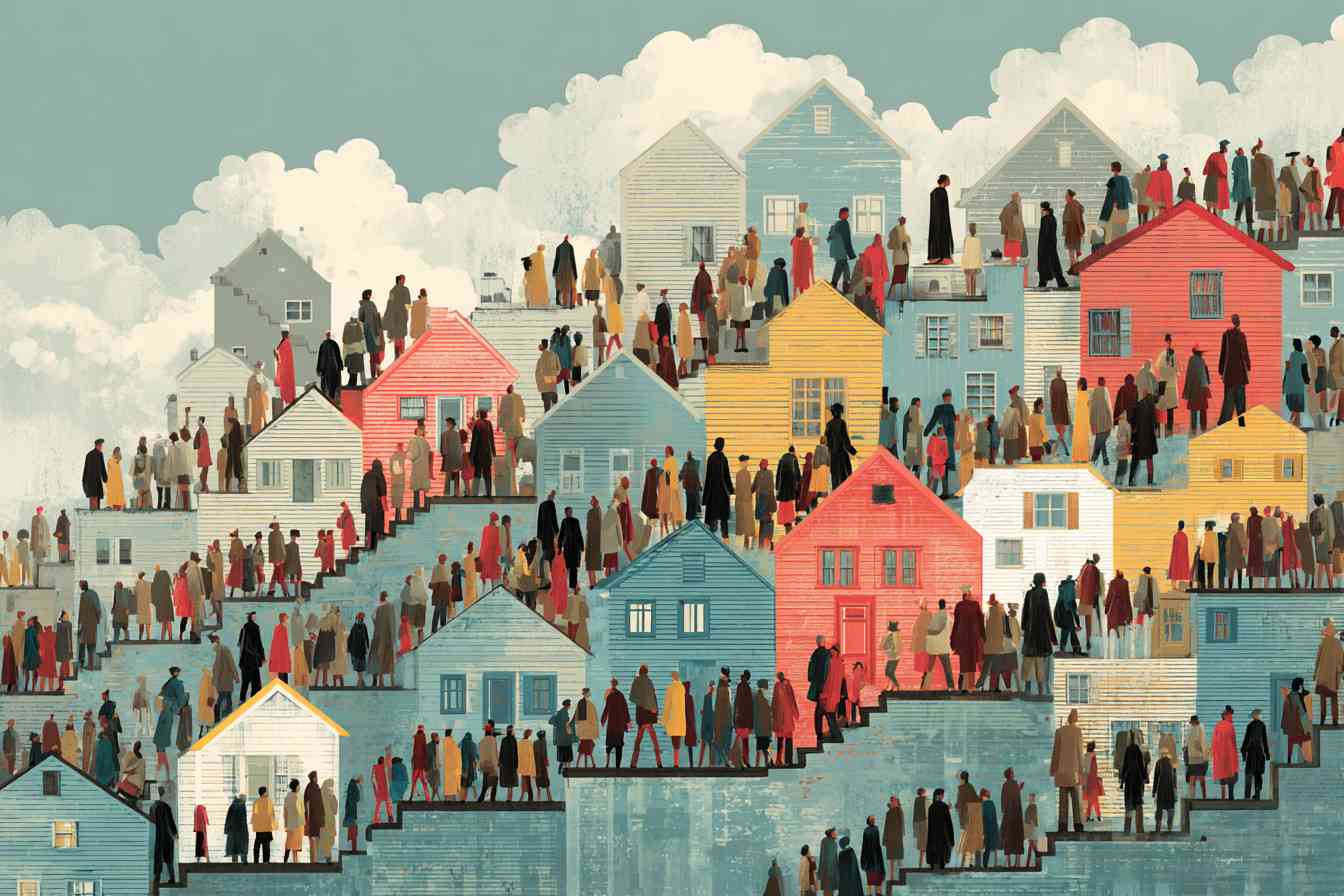Overcrowded and unaffordable: how mass immigration fuels the housing crisis in the Netherlands

An exploding population in a small country
The Netherlands is a small country, both in geography and in the capacity of its infrastructure. Yet it has one of the fastest-growing populations in Europe, and much of that growth is not due to birth rates but migration. As the demand for housing skyrockets, political leaders and urban planners blame everything from zoning laws to NIMBYism. But what is often deliberately omitted from public discussion is the real root of the problem: the country is simply being overwhelmed by the number of people entering it, outpacing the nation’s ability to build homes.
Between 2015 and 2023, the population of the Netherlands increased by over 1 million people. According to the Centraal Bureau voor de Statistiek (CBS), nearly 80 percent of this growth was due to migration (Bevolking; kerncijfers, CBS). This is not a natural development but the result of policy decisions by successive governments that have actively chosen to encourage and sustain high levels of immigration.
The disconnect between policy and reality
The Dutch government continues to push for ambitious housing plans, such as the pledge to build 900, 000 new homes by 2030 (Nationale Woon- en Bouwagenda, Ministerie van BZK). However, these targets are set against a backdrop of massive, ongoing immigration inflows. In 2022 alone, 402, 000 new immigrants entered the country (Migratie naar Nederland, CBS), a record-breaking number. Even with high construction targets, supply is unlikely to catch up with demand when the population increases by hundreds of thousands annually.
Rather than adjust migration policy to relieve pressure, politicians continue to frame the housing shortage as a purely logistical challenge. Housing Minister Hugo de Jonge has repeatedly insisted the solution lies in “building faster, ” while ignoring how immigration itself is one of the key variables driving demand. As a result, the housing market is not simply strained, it is structurally destabilized.
The myth of refugee numbers being small
One argument often used to downplay the problem is that the number of asylum seekers is “not that big” compared to the total population. However, this argument fails to account for cumulative effects over time, family reunification policies, and the fact that housing policy guarantees accommodation for “statushouders” (recognized asylum permit holders) in municipalities. These groups are given priority access to social housing, pushing native Dutch citizens further down the waiting list.
According to the Association of Dutch Municipalities (VNG), the legal obligation to house permit holders has put enormous pressure on the already struggling social housing system (Brief aan Tweede Kamer over huisvesting statushouders, VNG). In cities like Amsterdam, The Hague, and Utrecht, waiting times for social housing now often exceed ten to fifteen years, and even longer for larger families.
In 2023, municipalities were tasked with housing over 20, 000 statushouders in just one year, a goal that was often not met, not because of unwillingness, but because there were simply no homes available (Stand van zaken huisvesting statushouders, Rijksoverheid). This means newcomers are placed in temporary shelters, hotels, or emergency facilities, further drawing on already-stretched local resources.
Immigration beyond asylum: the silent numbers
While public attention often focuses on refugees from conflict zones, a significant portion of immigration into the Netherlands comes from other sources: labor migrants from Eastern Europe, students from abroad, and family reunification cases. These categories receive far less scrutiny but add significantly to the population pressure.
The European Union’s free movement policy means that people from any EU country can move to the Netherlands without limitation. In practice, this has resulted in large numbers of labor migrants, particularly from Poland, Romania, and Bulgaria, settling in the country. According to a 2023 report from the Dutch Council for Government Policy (WRR), migrant workers now account for a substantial and growing share of total population growth, especially in peripheral municipalities (Grip op migratie, WRR).
Moreover, Dutch universities have internationalized rapidly, accepting increasing numbers of foreign students who often stay in the country after graduation. The housing demand this generates is enormous, particularly in student cities like Groningen, Delft, and Nijmegen. The education sector benefits financially from these students, but it is local residents who bear the consequences in the form of skyrocketing rents and housing shortages.
Urban pressure and zoning myths
One common excuse given by government officials is that local zoning laws and environmental regulations delay housing projects. While this is partially true, it is a distraction from the core issue. The real problem is that the rate of housing demand far exceeds any plausible supply that can be built under democratic or environmental norms.
Urban sprawl is limited by geography, as the Netherlands is densely built and much of its territory is polderland, subject to flooding or protected nature. Building faster becomes meaningless if the number of residents continues to expand faster still.
Municipalities that attempt to scale back immigration inflows or prioritize local residents in housing policies are often overruled by national or EU law, as such policies are deemed discriminatory. The central government thus maintains tight control over migration, while local governments are left with the fallout.
How the EU contributes to the crisis
The housing shortage in the Netherlands is not just a national problem, but a symptom of broader European Union policies that erode national control over population size. Through the Schengen agreement and freedom of movement regulations, the EU compels member states to allow unrestricted migration between countries. This has enabled mass movement from poorer EU nations to wealthier ones like the Netherlands, without any mechanism to match this movement with infrastructure or housing capacity.
Furthermore, EU directives on refugee resettlement, non-discrimination, and family reunification override local priorities. National efforts to limit housing benefits for non-citizens or to reserve homes for native residents are routinely struck down by the European Court of Justice as violations of EU law. This leaves the Netherlands with no meaningful tools to regulate the demographic pressure it faces, even when it directly undermines housing affordability, social services, and societal stability. The EU’s immigration framework does not acknowledge capacity constraints, and treats all migration as beneficial, regardless of the consequences on the ground.
The generational impact: young people priced out
Perhaps the most visible and tragic consequence of the housing crisis is the growing inability of young Dutch citizens to find an affordable place to live. Median house prices have doubled over the last ten years, with rents also surging, particularly in the private sector.
According to Rabobank, more than 60 percent of Dutch renters under age 35 spend over 40 percent of their income on rent (Woonlasten jongeren, Rabobank). Many young adults are forced to live with parents well into their late twenties or thirties, delaying not only independence but also family formation and home ownership. This has long-term economic and social consequences, as the traditional Dutch model of upward mobility through home ownership erodes.
At the same time, many homes are being reserved for non-citizens. Refugees, foreign students, and temporary workers are often placed in housing that locals cannot access, creating a sense of institutional betrayal and fuelling resentment that political elites seem unwilling to confront.
The dogma of growth
Why does the Dutch political class continue to invite more people into a country that cannot house its own citizens? The answer lies in a deeply held dogma: that economic growth is always good, and that population growth fuels economic activity. Migration is seen not as a burden, but as a solution to supposed labor shortages, demographic aging, and tax base erosion.
This logic ignores the quality-of-life deterioration for ordinary citizens. Schools become overcrowded, hospitals face longer waiting times, and public transport is stretched beyond capacity. Housing is merely the most visible part of a broader social overstretch.
The economic benefits of immigration are also unevenly distributed. Large corporations benefit from a cheap, flexible labor force. Universities benefit from international student tuition. Real estate investors gain from rising property prices. But the average citizen sees their rent go up, their wages stagnate, and their children priced out of the cities they grew up in.
This dynamic is no accident. As sociologist Paul Scheffer noted, the discussion on immigration is often shaped by those who benefit from it, while the costs are borne by those with the least political influence (Het land van aankomst, Paul Scheffer).
The European dimension: forced accommodation
Dutch housing policy is no longer fully national. The European Union plays a significant role in shaping migration through its free movement rules, Schengen agreement, and refugee resettlement schemes. In several cases, national governments have been pressured by the European Commission or European Court of Justice to comply with broader migration directives.
For example, the Netherlands was required to accept refugee quotas during the 2015 migrant crisis, despite local and national opposition. Efforts to prioritize housing for Dutch citizens over EU or refugee claimants are often blocked by European legal rulings on non-discrimination and freedom of movement.
In effect, the Netherlands has lost sovereignty over who it allows to live within its borders, and by extension, over its ability to plan rational housing policy. Without control over the size and composition of its population, housing plans become reactive rather than proactive, always chasing a moving target.
The taboo of demographic realism
Critics of current policy are often labelled xenophobic or far-right, even when they present factual, data-driven critiques. This has created a toxic political climate where honest discussion is stifled and real solutions remain out of reach.
What is needed is demographic realism: the recognition that a small, densely populated country cannot absorb unlimited numbers of newcomers without catastrophic consequences for housing, infrastructure, and social cohesion. This is not a matter of ideology, but arithmetic.
Countries like Japan and Hungary, which have adopted more restrictive migration policies, do not face the same level of housing stress. While not without challenges, they prove that high immigration is not the only way to sustain a modern economy. It is a choice, not an inevitability.
A population problem in disguise
Ultimately, the housing crisis is not just a policy failure. It is the natural result of a population crisis that no one dares to name. The Netherlands is being asked to accommodate too many people, too quickly, without regard for capacity or consent. It is not a shortage of homes, but an overabundance of demand.
This imbalance will only worsen as long as migration remains untouchable in public discourse. Housing shortages, rising rents, and displaced citizens are not temporary issues. They are symptoms of a deeper, structural transformation of Dutch society, driven not by the needs of its people, but by the priorities of international institutions and corporate interests.
The first step toward solving the housing crisis is to speak honestly about its cause.


















